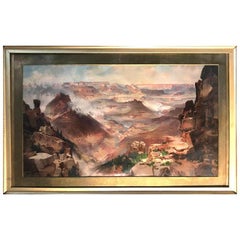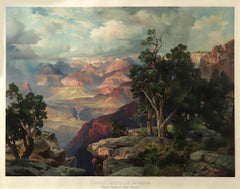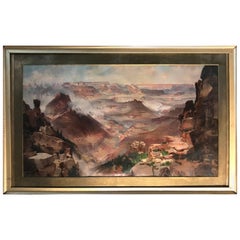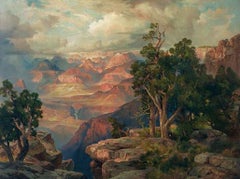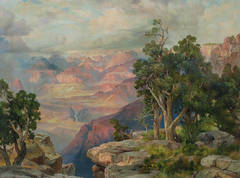Moran Chromolithograph
Late 19th Century Landscape Prints
Lithograph
1910s American Impressionist Landscape Prints
Lithograph, Color
Antique 1890s American Prints
Paper
1910s Hudson River School Landscape Prints
Paper, Lithograph
Recent Sales
1910s Hudson River School Landscape Prints
Paper, Lithograph
1910s Hudson River School Landscape Prints
Paper, Lithograph
People Also Browsed
Antique Early 19th Century English Georgian Balustrades and Fixtures
Wrought Iron
2010s Brazilian Swivel Chairs
Straw
Early 20th Century American Edwardian Tea Sets
Sterling Silver
Vintage 1910s British Books
Paper
Antique Late 19th Century French Gothic Benches
Iron
2010s European Books
Other
Antique Early 1900s French Neoclassical Revival Centerpieces
Wood
Early 20th Century French Figurative Sculptures
Marble, Spelter
Antique Early 19th Century Russian Russian and Scandinavian Rugs
Wool
Antique 19th Century English Rococo Sterling Silver
Sterling Silver
20th Century British Renaissance Tapestries
Ceramic
Antique Late 19th Century Japanese Meiji Vases
Metal
Antique 18th Century Italian Rococo Sofas
Walnut
Early 1900s Hudson River School Landscape Paintings
Oil Crayon, Laid Paper
Antique 19th Century Sports Equipment and Memorabilia
Silver
Antique 18th Century English Neoclassical Console Tables
Alabaster, Marble, Gold Leaf
Thomas Moran for sale on 1stDibs
Thomas Moran was born in 1837 in Bolton, England. He was an American painter and printmaker of the Hudson River School in New York, whose work often featured the Rocky Mountains. Moran and his family took residence in New York, where he obtained work as an artist. A talented illustrator and exquisite colorist, he was hired as an illustrator at Scribner's Monthly. During the late 1860s, he was appointed the chief illustrator of the magazine, a position that helped him launch his career as one of the premier painters of the American landscape. Moran along with Albert Bierstadt, Thomas Hill, and William Keith are sometimes referred to as belonging to the Rocky Mountain School of landscape painters because of all of the Western landscapes made by this group. He began his artistic career as a teenage apprentice to the Philadelphia wood-engraving firm Scattergood & Telfer. He found the engraving process "tedious" and spent his free time working on his own watercolors. By the mid-1850s, he was drawing the firm's illustrations for publication rather than carving them and he began studying with local painter James Hamilton, who introduced him to the work of British artist J. M. W. Turner. Moran traveled to England in 1862 to see Turner's work and he often acknowledged that the artist's influence on his use of color and choice of landscapes. During the 1870s and 1880s, Moran's designs for wood-engraved illustrations appeared in major magazines and gift oriented publications. He was married to Scottish born Mary Nimmo Moran (1842–99), an etcher and landscape painter. The couple had two daughters and a son. His brothers Edward (1829–1901), John (1831–1902) and Peter (1841–1914), as well as his nephew Jean Leon Gerome Ferris (1863–1930), were also active as artists. He died in Santa Barbara, California on August 26, 1926. Moran's vision of the Western landscape was critical to the creation of Yellowstone National Park. In 1871, Dr. Ferdinand Hayden, director of the United States Geological Survey, invited Moran, at the request of American financier Jay Cooke, to join Hayden and his expedition team into the unknown Yellowstone region. Hayden was just to embark on his arduous journey when he received a letter from Cooke presenting Moran as.. "an artist of Philadelphia of rare genius. . ." Funded by Cooke (the director of the Northern Pacific Railroad) and Scribner's Monthly, a new illustrated magazine, Moran agreed to join the survey team of the Hayden Geological Survey of 1871 in their exploration of the Yellowstone region. During 40 days in the wilderness area, Moran visually documented over 30 different sites and produced a diary of the expedition's progress and daily activities. His sketches along with photographs produced by survey member William Henry Jackson captured the nation's attention and helped inspire Congress to establish the Yellowstone region as the first national park in 1872. The paintings of Moran along with the photographs of Jackson revealed the scale and splendor of the beautiful Yellowstone region more than written or oral descriptions, persuading President Grant and the US Congress that Yellowstone was to be preserved. Naturally proud of the role he played, Moran adopted a new signature: T-Y-M, Thomas "Yellowstone" Moran thereafter. After his involvement with Hayden expedition, Moran began publishing his work in various periodicals and produced several large paintings, including The Grand Canyon of the Yellowstone (1872) and Chasm of Colorado (1873–74), which were purchased by the US Congress to hang in the U.S. Capitol (now on view at the Smithsonian American Art Museum). Over the next 40 years, he traveled extensively. He was elected to the membership of the National Academy of Design in 1884 and produced numerous works of art in his senior years. Legacy The Thomas Moran House in East Hampton, New York is a National Historic Landmark. Mount Moran in the Grand Teton National Park is named for Moran.
Finding the Right Prints-works-on-paper for You
Decorating with fine art prints — whether they’re figurative prints, abstract prints or another variety — has always been a practical way of bringing a space to life as well as bringing works by an artist you love into your home.
Pursued in the 1960s and ’70s, largely by Pop artists drawn to its associations with mass production, advertising, packaging and seriality, as well as those challenging the primacy of the Abstract Expressionist brushstroke, printmaking was embraced in the 1980s by painters and conceptual artists ranging from David Salle and Elizabeth Murray to Adrian Piper and Sherrie Levine.
Printmaking is the transfer of an image from one surface to another. An artist takes a material like stone, metal, wood or wax, carves, incises, draws or otherwise marks it with an image, inks or paints it and then transfers the image to a piece of paper or other material.
Fine art prints are frequently confused with their more commercial counterparts. After all, our closest connection to the printed image is through mass-produced newspapers, magazines and books, and many people don’t realize that even though prints are editions, they start with an original image created by an artist with the intent of reproducing it in a small batch. Fine art prints are created in strictly limited editions — 20 or 30 or maybe 50 — and are always based on an image created specifically to be made into an edition.
Many people think of revered Dutch artist Rembrandt as a painter but may not know that he was a printmaker as well. His prints have been preserved in time along with the work of other celebrated printmakers such as Pablo Picasso, Salvador Dalí and Andy Warhol. These fine art prints are still highly sought after by collectors.
“It’s another tool in the artist’s toolbox, just like painting or sculpture or anything else that an artist uses in the service of mark making or expressing him- or herself,” says International Fine Print Dealers Association (IFPDA) vice president Betsy Senior, of New York’s Betsy Senior Fine Art, Inc.
Because artist’s editions tend to be more affordable and available than his or her unique works, they’re more accessible and can be a great opportunity to bring a variety of colors, textures and shapes into a space.
For tight corners, select small fine art prints as opposed to the oversized bold piece you’ll hang as a focal point in the dining area. But be careful not to choose something that is too big for your space. And feel free to lean into it if need be — not every work needs picture-hanging hooks. Leaning a larger fine art print against the wall behind a bookcase can add a stylish installation-type dynamic to your living room. (Read more about how to arrange wall art here.)
Find fine art prints for sale on 1stDibs today.
